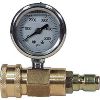This illustrates that developing loads in your rifle or handgun is dependent on manuals and internet data from trusted sites, and have to be treated as guides only, and not etched in stone.
The more data that you can accrue from different trusted sources, the better that you can determine Start and Max loads for your firearm. You can never have too much data. There is often a wide discrepancy in different sources of data as to start and max loads and the given pressures indicated. There are many reasons for this, and it can be from different components used, to the test fixture or firearm used in determining min and max loads.
When you add your firearm to the equation, you have to determine when you have reached the pinnacle for accuracy with acceptable velocity and pressure. Usually, accuracy is found somewhere in the middle of min and max data.
You can do that by adhering to the data listed and observing your fired brass and being aware of your firearms bolt lift and brass extraction. This is a learned technique that comes with experience.
Always err on the side of caution, and remember that reloading can be dangerous on the shooting side, if you do not follow proper procedures.
NCsmitty




